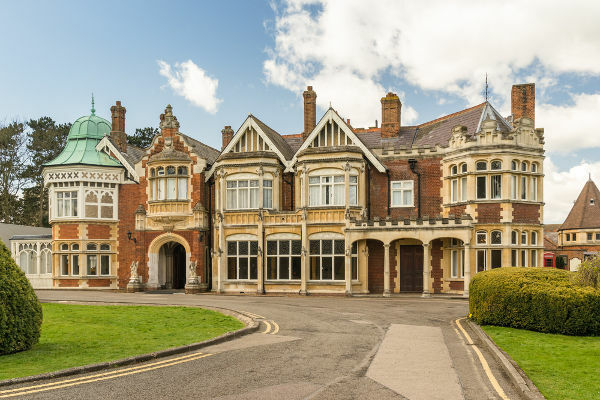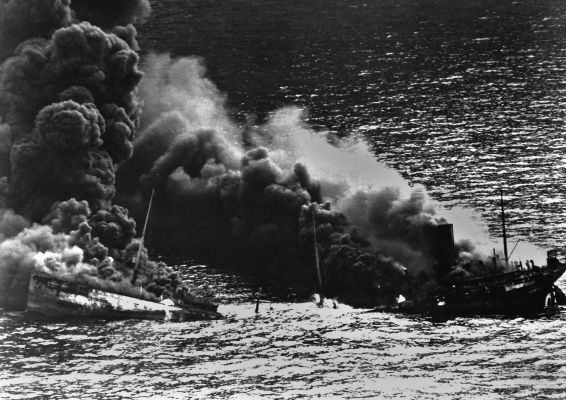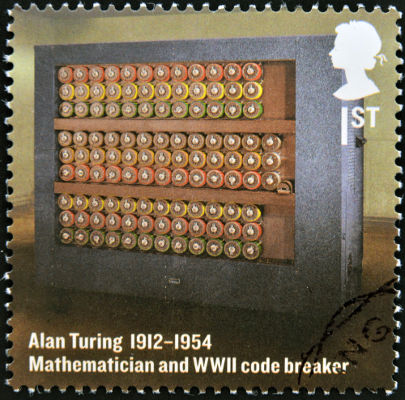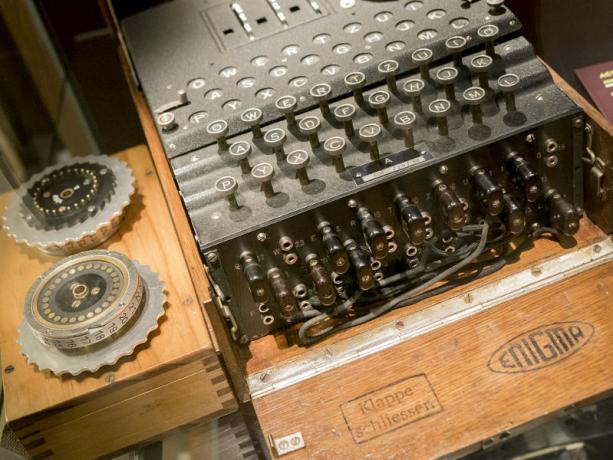Alan Turing was an English mathematician and cryptographer currently regarded as the father of computing, since, through his ideas, it was possible to develop what we now call a computer. Turing was also well known as one of those responsible for deciphering the code used by Nazi communications during the Second World War.
Through his work, a machine known as the “electromechanical pump” (The Bombe) was developed, which deciphered the Enigma machine code used by the Germans, and allowed the Allies access to privileged information throughout the war. Turing died in 1954, probably having committed suicide.

Also access: Learn about the life of one of the 20th century's leading scientists
Personal life
Alan Mathison Turing was born on June 23, 1912, in a residential neighborhood of London, capital of England. his father, JuliusMathisonTuring, he was an officer who worked in the Madras Presidency, an administrative region created by the British in British India (at the time, India was a dependent territory of England). His mother,
EthelSaraStoney, she was the daughter of a chief engineer who also worked in that region.During his childhood, Turing studied at various schools such as Hazelhurst Preparatory School and Sherborne School. He joined Sherborne when he was 13, and a peculiar episode marked your entry into it. On his first day of school, there was a general strike in Britain that prevented him from going by train. Turing decided, on his bicycle, to travel the 100 km that separated the school from his home.
Do not stop now... There's more after the advertising ;)
Some studies of Turing's life show that at Sherborne he soon showed great interest. by math, and despite being recognized today as a genius, some of his grades were just regular. In Sherborne, he met Christopher Morcom, which many believe was yours first love.
Morcom, however, died in 1930 as a result of bovine tuberculosis. At this point, Turing was 18 years old. Years later, he joined the Mathematics course at Cambridge University, and graduated in 1934 with honors. After that, he devoted himself fully to the math and the cryptography.
Also access: The fuse that started World War II in 1939
Professional life

In 1936, Turing put forward a theory about building a machine capable of performing calculations. Between 1936 and 1938, studied mathematics and cryptography at Princeton, where he got his PhD. From 1938, he returned to England and joined an organization of the British government, responsible for breaking codes and riddles, called Government Code and Cypher School.
With the start of World War II in September 1939, Turing joined the Bletchley Park, the installation that brought together great mathematicians and cryptographers and that played a crucial role in intercepting messages sent by the Axis armies (formed by Italy, Germany and Japan). In this installation, there was an intense cooperation of English, French and Polish scientists to decipher the code used by the Germans and their allies.
Know more:Alliances for World War II
The Germans used the Puzzle, a German machine that encrypted the messages that were sent by the army and made them almost undecipherable. Alan Turing and other English mathematicians were directly involved in breaking the German code, and for that they relied on studies carried out by three Polish mathematicians, who worked between 1932 and 1939.
The French granted the British cryptographic keys used by the Wehrmacht (German army), and the Poles gave them Enigma machines. In 1940, the British managed to decode the first messages sent by the Germans, but only with Bombbe it was possible to decode them at the speed demanded by the war.
The machine used by the British to decode the messages was the result of Turing's work. His theory was inspired by Polish studies MarianRejewski, and the execution of the work was carried out by the engineer HaroldKeen. The importance of Turing is given because it was he who, even in 1939, stated that it was possible to build a new artifact capable of breaking the German code. This is because the Poles had already developed an electromechanical bomb, but as the cryptanalysis principle of the Polish bomb was fragile, this machine soon became obsolete.
Alan Turing was also responsible for recruiting Tommyflowers to the Bletchley Park cryptography department. Flowers, years later, ended up being responsible for building the colossus, an important machine that deciphered the code of a German encryption machine called Lorenz.
Importance in World War II

THE first electromechanical pump developed through the studies of Alan Turing was completed in March 1940 and was named Victory. Machines built on this model developed by Alan Turing were essential for the Allies in World War II, because they gave them a strategic advantage extremely important: information.
The messages deciphered by the Bombe de Turing were part of the Ultra — British intelligence department responsible for intercepting and deciphering messages sent by the Axis communication systems. Ultra played an outstanding role in receiving German messages and also contributed to deciphering Japanese codes.
This was a huge department, coming to rely on six thousand workers, of which Alan Turing was one of the most prominent names. Because of its importance, this department was known only to the highest echelon of the British government and army. the soviet leader josephStalin, for example, he never knew how the British managed to get information from the Germans.
Historian Max Hastings argued that the Ultra (of which the electromechanical pumps were a part) was responsible for saving the destruction of about two million tons of British vessels in the second half of 1941.|1| Through the information decoded by the machine designed by Turing, the British managed to map the position of German vessels, and, with this, it was possible to divert the route of the English vessels with anticipation.
This was extremely important because, between 1940 and 1941, the UK was fighting alone in the war, as the French had been quickly defeated. The isolated British island was eventually surrounded by German submarines called U-boats, which sank ships carrying supplies to the UK. With Bombe, it was possible to work around this problem.
In 1943, the machines developed by Turing demonstrated their importance for British intelligence, as they were responsible for deciphering, each month, about 84 thousand messages sent by the Germans via Enigma.|2|
The decoding system developed by Turing and his team and the work developed through Ultra also contributed to battles held in North Africa, in Greece, at Normandy etc. In addition to helping the victory, Turing and his invention contributed to shorten the time of World War II and were responsible for save the lives of millions of people.
Also access: Forms of Communication during World War II
The Bombe: The Turing Machine
As mentioned, Turing's machine, or his electromechanical bomb, was used to decipher messages issued by the German armed forces and encrypted by another machine called Enigma. These messages were issued in the form of radio waves, so they were easily intercepted at Bletchley Park.

Bombe was a huge computerelectromechanical that weighed almost a ton and there was about 1.80 m height. On the front of the machine, there was 108 axes, which were grouped into nine lines with 12 cylindrical spaces. in these cylinders were fitted into the drums, which, after being manually programmed, using cards with small holes, rotated simultaneously, combining the letters of each drum with the messages captured in groups of three letters.
The drums started the combination in a certain letter and, at the end of each cycle, its position was incremented to the next letter, thus, the cycle was started again. In all, each cycle went through a total of 17,576 different positions. Now, let's understand how the machine that encoded the communications carried out by the Nazis and which was deciphered through Turing's work worked.
Lookalso:What are transistors?
Enigma: How It Worked
As mentioned, the Poles were responsible for building the first electromechanical pumps. They have had some success in deciphering Enigma encrypted messages, however, this success has drastically diminished as the German machine was improved by Nazi engineers. One of these implementations made it indecipherable. However, the capture some encryption keys made it possible to break the Nazi codes. It was in this scenario that the programming made by Alan Turing and his team showed its usefulness.
The computer scientist had the idea to implement a new electromechanical pump, more efficient than the previous ones. To do so, it programmed it predicting the existence of repeated excerpts in most of the messages, moreover, I knew how to exploit a major flaw in the cryptography used by Enigma, which we'll talk about later.

THE Puzzle could be configured in 26 modes different encryption keys, based on the position in which three mechanical axes were connected to each other. The letter present in the first axis determined which would be the following letters. Thus, if the first letter was A, for example, when typing the letter J, this was replaced by the letter B, however, if the initial letter was B, the letter J would be replaced by the letter C. THE The initial letter of each message was therefore the cryptographic key. of each message, and therefore it was changed every day, exactly at midnight.
Alan Turing and his team knew how the position of Enigma's axes changed the encryption of messages and also that this setting was changed every day. In one of his attempts to crack the encrypted code, Turing developed a technique what Bombe was looking for “attack” a specific phrase that was repeated in the same position, in all messages exchanged between the Nazi armed forces. In addition, the English scientist also benefits from a big flaw of the german machine: she was not able to encrypt a message without changing all of its letters.
This indicated that if the original sentence contained the letter A, for example, the encrypted letter could never be A, regardless of what configuration the machine was in. Based on this, Bombe looked for the phrase that was repeated and combined it with the other 26 possibilities of configuration, captured over time, until, in any of these combinations, the same letter does not repeat. The phrase in question, present at the end of every message, was "Heil Hitler" (save Hitler).
Lookalso:Einstein and the atomic bomb
Last years of Turing
After the war, Turing continued his work on developing a computer and a artificial intelligence and worked at places such as the National Physical Laboratory, linked to the British government, and the University of Manchester.
In January 1952, he had his house robbed by the young man with whom he was in a relationship, and when he admitted to the police his involvement with the assailant, he was indicted for "serious indecency". At that time, the homosexuality was prohibited in England, and that brought Turing to trial.
Convicted of grave indecency, the mathematician was forced to withdraw from his craft. To avoid being arrested, Turing agreed to go through a "treatment" based on estrogen (female hormone) which actually consisted of a chemical castration. On June 8, 1954, at the age of 41, Alan Turing was found dead in your house.
the cause of death was poisoning by çianide, possibly from ingesting an apple poisoned with this compound. Thus, his death was recorded as a result of a suicide, although family members of the mathematician argued years later that it happened by mistake. Turing's remains were cremated, and to this day it is not known whether his death was accidental or deliberate.
In 2009, the British Prime Minister Gordonbrown he publicly apologized for the way the British government dealt with Alan Turing after the war. In 2013, the queen Elizabeth II granted royal pardon to the scientist, posthumously releasing him from his previous condemnation of his homosexuality.
See too:Informatics — information processing by computers
Alan Turing's legacy
The greatest legacy left by mathematician Alan Turing is, without a doubt, the invention of Turing machine. this is a modeltheoretical that can be used to implement all the logical and mathematical aspects of a computer, regardless of how it is built (mechanically or electronically, for example).
Turing's machine was created in 1936, long before the invention of modern computers. Most of our electronic devices like cell phones and computers, are programmable machines that operate according to the fundamentals of machineinTuring. At calculators, for example, operate like the first Turing machines, programmed to perform simple calculations.
As mentioned, Turing's participation in the deciphering of Enigma and in the construction of the electromechanical pump contributed to accelerating the end of World War II, being responsible for saving millions of lives. In addition, during this period, the Encryption and computing technologies have made great strides.
In addition to building the foundations of modern computing, Turing also developed the first tests capable of distinguish artificial intelligence from human intelligence. Currently the Turing tests are used on various websites and devices, providing greater security for its users.
Grades
|1| HASTINGS, Max. Hell: the world at war 1939-1945. Rio de Janeiro: Intrinsic, 2012, p. 294.
|2|Alan Turing: the codebreaker who saved ‘millions of lives’. To access, click on here.
*Image credits: Anait and Shutterstock
By Daniel Neves graduated in History and
Rafael Helerbrock Master in Physics

